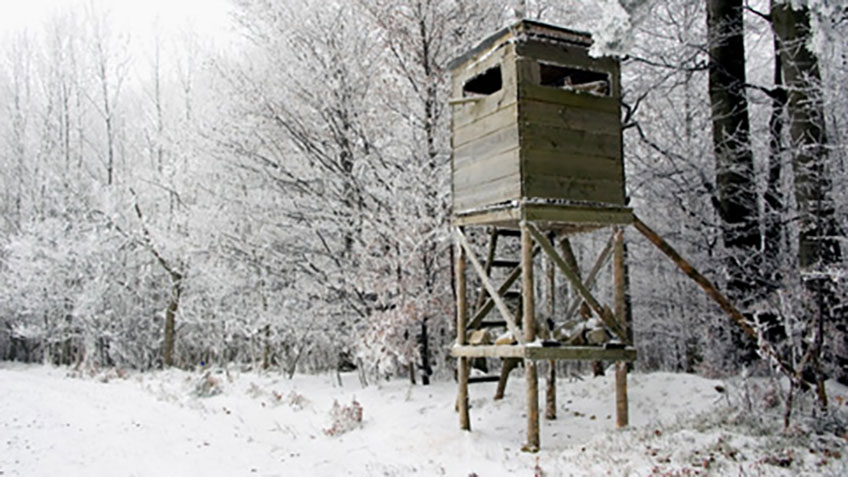
1) Fuel Up: Your body needs fuel to burn to keep you warm. That means a solid breakfast and packing snacks so you can top off your tank every couple of hours. Carbohydrates are the key—stuff like pancakes and peanut butter toast stick to your ribs and provide lots of fuel. Go easy on the caffeine, since it makes all of us pee too much, but some have been known to bring along a small vacuum bottle with decaf hot tea.
2) Base Layer: A light wicking base layer should be the foundation of your clothing system. One of the real keys to remaining warm is to keep from getting wet with sweat, which means a set of lightweight wicking thermal underwear is required. As a side note, never wear anything made of cotton, which soaks up water and will not block the wind. Only synthetics or wool will do. Under Armour boxers and t-shirts form a great base, covered next by lightweight Under Armour Cold Gear.
3) Mid-Layers: Over the base layer I add one or more layers of long underwear, depending on how cold it is. I like this rather than depending on one bulky set that usually ends up being too hot or too cold. In extreme weather I add a set of fleece longies, and have been known to wear as many as three layers of this stuff. Many manufacturers offer a system approach to their long underwear products. Again, the key is using synthetic materials, not cotton.
4) Shirt: Over the longies goes my wool Sleeping Indian Designs Highline shirt. It’s super warm, soft and easy to move in.
5) Outerwear: Your outerwear must do two things extremely well—keep the weather off you, and allow you the freedom to shoot with gun or bow. It must also be quiet enough that it will not spook deer in the silence of a still day. This season I have extensively worn Sitka Gear’s Incinerator Jacket & Bibs. Both come in Optifade Forest camo, designed using the science of deer vision. The jacket is formfitting, features a Gore-Tex waterproof, breathable membrane that blocks the wind, a drop-away hood, all sorts of high-tech features and a lightly-brushed face for quiet. Same with the bibs. I really like this stuff.
6) Feet: Nothing gets colder faster than your feet on a cold-weather stand. For really bitter, zero-degree or lower temperature try Cabela’s Saskatchewan Pac Boots. They feature a 13 mm Texel removable liner that reflects heat inward to minimize loss, while underneath there is a moisture trap footbed that wicks away perspiration and condensation. The ½-inch layer of EVA foam, coupled with the nylon-covered Phylon midsoles, put 3 inches of cold-blocking material between your feet and the ground. The Gore-Tex Scent Control liners are waterproof and breathable—critical in a cold-weather boot. I have worn these guys at minus 30 degrees Farenheit in a tree stand in Canada and my feet stayed warm. Buy them 2-3 sizes too big so there is an air pocket near your toes.
7) Head: You can lose up to 80 percent of your body heat from your head, which is why a jacket with a hood is a good idea. When the weather gets brutal I wear a Bomber-style ear-flap Northbound hat made by Sleeping Indian Designs I got two decades ago. It’s awesome. I also always pack along a balaclava and neck gaiter made from fleece.
8) Hands: When it's near zero degrees, I bring my heavy Gore-Tex ski gloves to walk to and from the stand. But on stand I like to shoot with the lightest gloves possible, so I wear a thin pair of fleece Browning Windstopper gloves. How do my hands stay warm? I never get on stand without a Vee-muff that belts around the waist. The best muffs have plenty of room for easy access with gloves on and some sort of wind-breaking membrane like Windstopper. I think a good muff is perhaps the most important piece of gear you can bring.
9) Hand & Toe Warmers: The little disposable hand and toe warmers by HeatMax and Grabber Performance Group are worth their weight in gold. I always have one (or two!) fired up inside my vee-muff, inside the boots on really bitter days, and even stashed along my kidneys and the back of my neck. You will never spend better money than buying these items by the case.
10) The Set-Up: Naturally you set stands where they need to be set. However, since I have found the time from mid-morning through late evening to be most productive for me now, I try and set stands so that the afternoon sun is on me and, most importantly, so I can prevent the prevailing winds from pounding me head-on for hours. I may come down out of the trees and use a ground blind, though I find it much easier to do so when hunting with firearms than archery gear.
How do you stay warm?




































